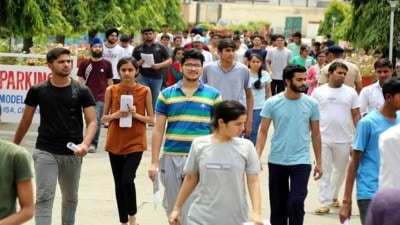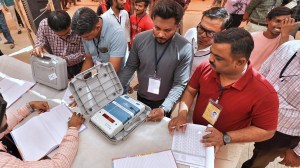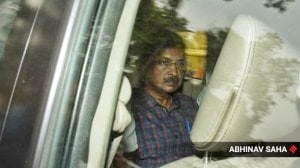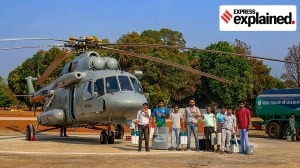- India
- International
UPSC Essentials: Key terms of the past week with MCQs
From Terrorist Organizations to Banking system liquidity— here's a highlight of some of the important terms useful for UPSC CSE Prelims and Mains preparation. Don't miss solving the MCQs and quiz yourself with Post Read Q&A.
 Key terms of the past week that you must not ignore. ( Representative image)
Key terms of the past week that you must not ignore. ( Representative image)Essential key terms from the last week’s news headlines or between the lines categorised as per the relevance in the UPSC-CSE syllabus. Solve the MCQs below. Also, Post Read Q&A will help you to self-evaluate your retention memory after reading the article.
Why in news?
— The National Investigation Agency (NIA) and the Enforcement Directorate (ED) on Thursday conducted searches at the Popular Front of India’s offices (PFI) and houses of PFI state and district level leaders across multiple states over alleged involvement in terrorist activities.
— The searches, based on allegations that members of PFI are involved in organising terror camps and encouraging youth to join terror activities, could also lead to a ban on the organisation under anti-terror laws.
Key takeaways
What is a “terrorist” organisation?
— Section 2(m) of the UAPA defines “terrorist organisation” as an organisation listed in the schedule to the UAPA, or an organisation operating under the same name as an organisation so listed in the Schedule.
— Schedule 1 currently lists 42 organisations, including Hizb-Ul-Mujahideen, Babbar Khalsa International, Liberation Tigers of Tamil Eelam, among others as terrorist organisations.
How is an organisation declared a terrorist organisation?

— Under Section 35 of the UAPA, the central government has powers to declare an organisation a terrorist organisation “only if it believes that it is involved in terrorism”.
— The schedule can be amended by the government to add or remove organisations from the list. The law states that an organisation shall be deemed to be involved in terrorism if it —
(a) commits or participates in acts of terrorism, or
(b) prepares for terrorism, or
(c) promotes or encourages terrorism, or
(d) is otherwise involved in terrorism.
Consequences of declaring an organisation a terrorist organisation
— The two crucial consequences of being declared a terrorist organisation is that the funding of the organisation, and the association of individuals with the organisation are criminalised.
— Section 38 of the UAPA requires a person who “associates himself, or professes to be associated, with a terrorist organisation with intention to further its activities, commits an offence relating to membership of a terrorist organisation” is punishable with imprisonment for a term not exceeding ten years.
— However, such individuals are exempted from the provision if they have been members before the organisation was declared a terrorist organisation and did not take part in any activities of the organisation at any time during its inclusion in the Schedule.
— Section 20 of the UAPA prescribes punishment for being member of terrorist gang or organisation. It states: “Any person who is a member of a terrorist gang or a terrorist organisation, which is involved in terrorist act, shall be punishable with imprisonment for a term which may extend to imprisonment for life, and shall also be liable to fine.”
— Section 21 prescribes punishment for individuals holding proceeds of terrorism with imprisonment for a term which may extend to imprisonment for life, and shall also be liable to fine.
—The UAPA under Section 24A also provides for forfeiture of proceeds of terrorism. The law states that even if the person is not convicted for being associated with a terrorist organisation, “proceeds of terrorism” can be forfeited to the Central Government or the State Government.
Recourse in law available to a terrorist organisation
— An application can be made to the central government to remove an organisation from the Schedule by the organisation itself or any person affected by inclusion of the organisation in the Schedule as a terrorist organisation.
— A review committee is then appointed which is headed by a sitting or former judge of a High Court to “judicially review” the application. The organisation will be removed if the review committee “considers that the decision to reject was flawed when considered in the light of the principles applicable on an application for judicial review”.
Point to ponder: What does a ‘ban’ on an organisation mean?
1. MCQ
Consider the following statements with respect to UAPA
1. Individuals are exempted from the provision of UAPA if they have been members before the organisation was declared a terrorist organisation.
2. An organisation shall be deemed to be involved in terrorism if it commits or participates in acts of terrorism prepares for terrorism, promotes or encourages terrorism, or is otherwise involved in terrorism.
3. Even if the person is not convicted for being associated with a terrorist organisation, “proceeds of terrorism” can be forfeited to the Central Government or the State Government.
Which of the statements is/are true?
a) 1 and 2
b) 2 and 3
c) 1 and 3
d) All of the above
Why in news?
— Union Tourism and Culture Minister G Kishan Reddy on Sunday announced a special tourist train to cover the “Ambedkar Circuit”. The modalities — such as the date of journey, ticket price, number of passengers —are still in the works.
Key takeaways
— The government had first proposed the Ambedkar Circuit, or Panchteerth, in 2016. Prime Minister Narendra Modi had said the Panchteerth would include Janma Bhoomi, Ambedkar’s birthplace in Madhya Pradesh’s Mhow; Shiksha Bhoomi, the place in London where he stayed while studying in the UK; Deeksha Bhoomi in Nagpur where he embraced Buddhism; Mahaparinirvan Bhoomi or the place of his demise in Delhi; and Chaitya Bhoomi, the place of his cremation, in Mumbai.
— With a special AC train, the government is looking to trace the footsteps of Ambedkar in India by giving better connectivity to four of these spots.
— The idea is to attract tourists beyond the Dalit community, who mostly visit these places as a pilgrimage. The journey will include meals, ground transportation, and entry to the sites.
Focus on tourism circuits
— The government had identified 15 tourist circuits under the Swadesh Darshan scheme in 2014-15.
— Besides the Ramayana and Buddhist Circuits, others include Coastal Circuit, Desert Circuit, Eco Circuit, Heritage, North East, Himalayan, Sufi, Krishna, Rural, Tribal, and Tirthankar Circuits. In terms of train collaboration, the Ramayana, Buddhist, and North East Circuits are already active, while Ambedkar will be fourth.
— As per government officials, the creation of special circuits allows them to focus better on the comprehensive development of all sites related to the theme, including infrastructure, road and rail connectivity, and visitor facilities. However, from the tourist’s point of view, not everyone visits all the sites related to a circuit in one go. It is to change this travel pattern that train collaborations have been devised, so that people come on board to
make the entire journey in one go.
— Officials in the Ministry of Tourism said that since every circuit involves more than one state, they look at data on the number of tourists visiting specific places on a circuit from time to time.
Point to ponder: India’s Dhamma traditions can show way towards post-pandemic life. Comment.
2. MCQ
Which of the following pairs is/are not correctly matched with respect to Ambedkar circuit?
a) Deeksha Bhoomi – Nagpur
b) Janma Bhoomi – Mhow
c) Shiksha Bhoomi – Mumbai
d) Mahaparinirvan Bhoomi – Delhi
Why in news?
— Prime Minister Narendra Modi announced the National Logistics Policy on Saturday (September 17), aimed at easing the movement of goods and boosting the trade sector in the Indian economy.
— Launched on the same day as there-introduction of cheetahs in India, the PM referred to the event by saying that luggage should move quickly like a cheetah while noting that currently, logistical costs account for 13 to 14 per cent of India’s GDP, almost double of what the costs are in developed countries.
Key takeaways
— The new logistics policy has four features: Integration of Digital System (IDS); Unified Logistics Interface Platform (ULIP); Ease of Logistics (ELOG); and System Improvement Group (SIG). Under the IDS, 30 different systems of seven departments are integrated – including data from the road transport, railways, customs, aviation and commerce departments.
— A Unified Logistics Interface Platform ULIP will “bring all the digital services related to the transportation sector into a single portal,” the PM said. Similarly, a new digital platform Ease of Logistics Services (E-Logs) has also been started for industry associations to resolve issues by reaching out to the government.
— The Prime Minister mentioned previous programmes and schemes aimed at improving logistics aspects, such as the FASTag for electronic toll tax collection and faceless assessment for customs. In terms of scale, the biggest of these plans is the Gati Shakti master plan, and the PM said: “A huge amount of information related to different infrastructure projects of state governments has been prepared. Today, data from the central and state governments in about 1500 layers are coming on the PM Gatishakti portal.”
Need of such a policy
— Logistics broadly includes facilities crucial to trade: transport services for the movement of goods, storage facilities that are particularly essential for trade in perishable goods such as food items, fruits, and vegetables, and smooth functioning of government services that facilitate trade such as licensing and customs.
— At the launch of the PM Gati Shakti-National Master Plan for multi-modal connectivity in October 2021, PM Modi had said: “According to a study, the logistical cost in India is about 13 per cent of GDP. Such a situation does not exist in developed countries. Due to high logistical cost, the competitiveness of India’s exports is greatly reduced.”
— In a Ministry of Commerce and Industry survey last year, titled ‘Logistics Ease Across Different States’, Gujarat, Punjab, and Haryana were ranked the top three states. The parameters included were the quality of road and railways infrastructure, road freight rates, quality of warehousing infrastructure, etc. The survey suggested that states should focus on areas such as developing sector-specific skilling infrastructure and streamlining logistics-related approval and clearance processes.
Point to ponder: How is the government focusing on improving logistics?
3. MCQ
With respect to the survey ‘ Logistics Ease Across Different Survey-2021’, which of the statements is not true?
a) It was released by Union Commerce and industry Ministry.
b) The LEADS survey assesses viewpoints of various users and stakeholders across value chain to understand the ‘enabler’ and ‘impediments’ to logistics ecosystem in the country.
c) Maharashtra retained its top slot for the third consecutive year followed by Haryana and Punjab among states.
d) Delhi stands at the top rank among Other UTs.
Why in news?
— In order to reduce the use of chemical fertilisers by incentivising states, the Union government plans to introduce a new scheme – PM PRANAM, which stands for PM Promotion of Alternate Nutrients for Agriculture Management Yojana.
— The proposed scheme intends to reduce the subsidy burden on chemical fertilisers, which is expected to increase to Rs 2.25 lakh crore in 2022-2023, which is 39% higher than the previous year’s figure of Rs 1.62 lakh crore.
Key takeaways
— A source told The Indian Express that the scheme will not have a separate budget and will be financed by the “savings of existing fertiliser subsidy” under schemes run by the Department of fertilisers.
— Further, 50 per cent subsidy savings will be passed on as a grant to the state that saves the money, sources said, and that 70 per cent of the grant provided under the scheme can be used for asset creation related to technological adoption of alternate fertilisers and alternate fertiliser production units at village, block and district levels.
— The remaining 30 per cent grant money can be used for incentivising farmers, panchayats, farmer producer organisations and self-help groups that are involved in the reduction of fertiliser use and awareness generation.
—A source said that the government will compare a state’s increase or reduction in urea in a year, to its average consumption of urea during the last three years. Data available on a fertiliser Ministry dashboard, iFMS (Integrated fertilisers Management System), will be used for this purpose, the source said.
Why this scheme?
— Due to increased demand for fertiliser in the country over the past 5 years, the overall expenditure by the government on subsidy has also increased.
— The total requirement of four fertilisers — Urea, DAP (Di-ammonium Phosphate), MOP (Muriate of potash), NPKS (Nitrogen, Phosphorus and Potassium) — increased by 21% between 2017-2018 and 2021-2022, from 528.86 lakh metric tonnes (LMT) to 640.27 LMT, according to a written reply given to Lok Sabha by Bhagwanth Khuba, the Union Minister of State for Chemicals and fertilisers.
— In light of the increased demand, the government has also been increasing the subsidies it provides for chemical fertilisers. In the Union Budget 2021-22, the government had budgeted an amount of Rs 79,530 crore, which increased to Rs 1.40 lakh crore in the revised estimates (RE). However, the final figure of fertiliser subsidy touched Rs 1.62 lakh crore in 2021-22.
— In the current financial year (2022-23), the government has allocated Rs 1.05 lakh crore, but the fertiliser Minister has stated that the fertiliser subsidy figure could cross Rs 2.25 lakh crore during this year.
—PM PRANAM, which seeks to reduce the use of chemical fertiliser, will likely reduce the burden on the exchequer. The proposed scheme is also in line with the government’s focus on promoting the balanced use of fertilisers or alternative fertilisers in the last few years.
How much fertiliser does India require?
— The kharif season (June-October) is critical for India’s food security, accounting for nearly half the year’s production of foodgrains, one-third of pulses and approximately two-thirds of oilseeds. A sizable amount of fertiliser is required for this season.
— The Department of Agriculture and Farmers Welfare assesses the requirement of fertilisers each year before the start of the cropping season, and informs the Ministry of Chemical and fertilisers to ensure the supply.
— The amount of fertiliser required varies each month according to demand, which is based on the time of crop sowing, which also varies from region to region. For example, the demand for urea peaks during June-August period, but is relatively low in March and April, and the government uses these two months to prepare for an adequate amount of fertiliser for the kharif season.
Point to ponder: What India needs to do to reduce its fertiliser bill?
4. MCQ
Which of the statements is not true with respect to fertilisers in India?
a) In order to reduce the use of chemical fertilisers by incentivising states, the Union government plans to introduce a new scheme – PM PRANAM.
b) Integrated Fertiliser Management System (iFMS) captures end to end details of Fertilizer in terms of Production, Movement, availability, requirement, Sale, Subsidy Bill Generation to Subsidy payment to fertilizer companies.
c) The Department of Agriculture and Farmers Welfare assesses the requirement of fertilisers each year before the start of the cropping season, and informs the Ministry of Chemical and fertilisers to ensure the supply.
d) A sizable amount of fertiliser is required for Rabi season as it accounts for nearly half the year’s production of foodgrains, one-third of pulses and approximately two-thirds of oilseeds.
Why in news?
— For the first time since May 2019, the banking system liquidity situation turned into a deficit mode of Rs 21,873.4 crore on September 20, 2022.
— By comparison, the liquidity surplus was to the tune of Rs 8 lakh crore in November 2021 as the Reserve Bank of India (RBI) was providing liquidity support to the economy, which was dealing with the after-effects of the Covid pandemic.
— On September 20, 2021, the liquidity surplus was Rs 6.7 lakh crore. Multiple factors are at play here: an uptick in the bank credit, advance tax payments by corporates, and also incremental deposit growth not keeping pace with credit demand.
Key takeaways
— Liquidity in the banking system refers to readily available cash that banks need to meet short-term business and financial needs. On a given day, if the banking system is a net borrower from the RBI under Liquidity Adjustment Facility (LAF), the system liquidity can be said to be in deficit and if the banking system is a net lender to the RBI, the system liquidity can be said to be in surplus. The LAF refers to the RBI’s operations through which it injects or absorbs liquidity into or from the banking system.
— Economists say that there are various factors over the last few months that have led to the current situation. If an improvement in demand for credit has led to the same, the recent advance tax outflow, which is a quarterly phenomenon, has further aggravated the situation.
— Besides, there is the continuous intervention of the RBI to stem the fall in the rupee against the US dollar.
“The deficit in the liquidity situation has been caused by an uptick in the bank credit, advance tax payments by corporates, intervention of the RBI into the forex market, and also incremental deposit growth not keeping pace with credit demand,” said D K Pant, chief economist, India Ratings.
— A tight liquidity condition could lead to a rise in the government securities yields and subsequently lead to a rise in interest rates for consumers too. The 10-year government bond yield increased to 7.23 per cent on September 21, 2022, from 7.18 per cent on August 20, 2022. Bank of Baroda’s economist Dipanwita Mazumdar said the short-term rates would increase at a faster pace as the direct reflection of tighter liquidity and RBI’s rate hike would be on these papers.
— A rise in the repo rate will lead to a higher cost of funds. Banks will increase their repo-linked lending rates and the marginal cost of funds-based lending rate (MCLR), to which all loans are linked to. This rise will result in higher interest rates for consumers.
How can RBI deal with the situation?
— Experts feel that RBI’s actions will depend upon the nature of the liquidity situation. If the current liquidity deficit situation is temporary and is largely on account of advance tax flow, the RBI may not have to act, as the funds should eventually come back into the system. However, if it is long-term in nature then the RBI may have to take measures to improve the liquidity situation in the system.
Point to ponder: ‘Liquidity management in the extended banking and financial system will be the key pillar of normalisation.’ What do you understand by this statement?
5. MCQ
If the RBI decides to adopt an expansionist monetary policy, which of the following would it not do? (2020)
- Cut and optimise the Statutory Liquidity Ratio
- Increase the Marginal Standing Facility Rate
- Cut the Bank Rate and Repo Rate
Select the correct answer using the code given below:
(a) 1 and 2 only
(b) 2 only
(c) 1 and 3 only
(d) 1, 2 and 3
Answer to the MCQs: 1 (d), 2(c), 3(d), 4(d), 5(b)
Post Read Q&A
Can you recall what you read?
- Which factors are responsible for banking system liquidity situation turning into a deficit mode?
- What is the major objective of PM-PRANAM?
- What is Panchteerth ?
Apr 18: Latest News
- 01
- 02
- 03
- 04
- 05






































